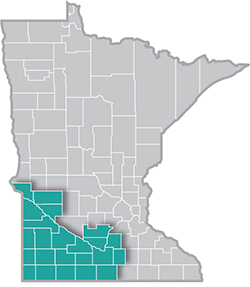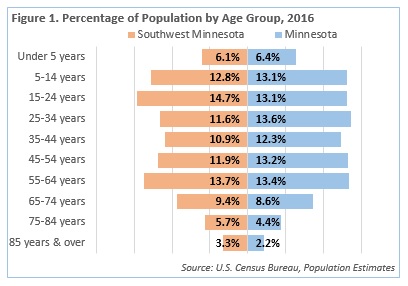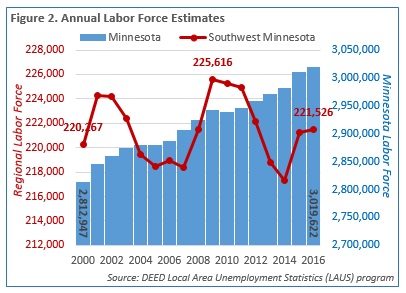 Southwest Minnesota is a national leader in agricultural production, and renewable energy.
Southwest Minnesota is a national leader in agricultural production, and renewable energy.
The region's thriving manufacturing sector includes food processing, machinery, printing, metal products, and computers and electronic products.
Want the freshest data delivered by email? Subscribe to our regional newsletters.
8/23/2017 10:09:32 AM
Luke Greiner
In August, DEED's Regional Analysis & Outreach Unit published updated 2017 Regional Profiles featuring new demographic, labor market and economic data for every region in the state.
The Southwest Minnesota planning region includes 23 counties, covering three Economic Development Regions (EDRs) and two Workforce Development Boards (WDBs). Southwest Minnesota was home to 391,702 people in 2016, comprising 7.1 percent of the state's total population. Only five of the 23 counties in Southwest Minnesota gained population from 2000 to 2016, with the other 18 seeing declines – including Swift County, the fastest declining county in the state.
The recent declines are part of a much longer-term trend in the region, where the population has declined by nearly 40,000 people since peaking in 1960. The entire region is projected to experience a population decline in the next 20 years, as well. According to population projections from the State Demographic Center, Southwest Minnesota is expected to lose just over 9,200 residents from 2020 to 2040, a -2.4 percent decline. In comparison, the state of Minnesota is projected to grow 8.8 percent.
Southwest Minnesota has a much older population than the rest of the state, with 18.4 percent of residents aged 65 years and over, compared to 15.2 percent statewide (Figure 1). Consequently, Southwest Minnesota had a lower percentage of people in the 25- to 54-year-old age group, typically considered the "prime working years," as well as a smaller percent of school-aged children. However, the region's several post-secondary institutions led to a higher percentage of people aged 15 to 24.

Southwest Minnesota's population is less diverse than the state's, but is becoming more diverse over time. In 2015, about 93.4 percent of the region's residents reported White alone as their race, compared to 84.8 percent of residents statewide. The region had much smaller percentages of Black or African American residents, Asian or Other Pacific Islanders, and people of Two or More Races. However at 6.0 percent, Southwest Minnesota had a higher percentage of people reporting Hispanic or Latino origin than the state, and a similar percentage of American Indians and people of Some Other Race.
Despite the region's population decline, Southwest Minnesota gained about 1,250 workers over the last 16 years, from 220,267 available workers in 2000 to 221,526 workers in 2016 (Figure 2). However, if Southwest Minnesota's population changes at the rates projected by the State Demographic Center, the region would see a decline of more than 8,000 workers from 2020 to 2030, a slow but steady 4 percent rate of decline. In comparison, the state's labor market is projected to expand by 2.4 percent, a gain of nearly 75,000 additional workers.

In addition to the overall decline, Southwest Minnesota's labor force will also see a significant shift over time, with large gains in the number of workers aged 65 years and over against huge declines in the number of workers aged 55 to 64 years. The region is also expected to lose teenaged workers and entry-level workers. However, the region is expected to see gains in the number of 25 to 44 year olds.
With 68.5 percent of the population aged 16 years and over in the labor force, Southwest Minnesota had slightly lower labor force participation rates than the state's 70 percent rate. However, the region actually had higher labor force participation rates than the state in all but one age group, but the overall rate appeared lower because a higher percentage of Southwest Minnesota's labor force was older.
Available workers were in high demand throughout the region, as employers struggled to find new workers to fill open jobs. The region had a ration of just 1.2 jobseekers per vacancy in 2016, down from a high of 7.6 job seekers per vacancy during the recession in 2009. While the region still hasn't fully regained all of the jobs lost during the recession, employers have been adding jobs in recent years.

Southwest Minnesota has seen employment ups and downs over the past decade, but ended 2016 with about 1,200 fewer jobs than it had in 2006. The region entered the recession later than the state, still experiencing job growth through 2008, before suffering severe declines in 2009 and 2010. Since then, Southwest Minnesota has recovered much more slowly than the state, which gained jobs at an 8.1 percent clip from 2011 to 2016, compared to a 2.4 percent increase in the region (Figure 3).
Thirteen of the 20 main industries in the region added jobs since 2011, with huge gains occurring in agriculture, transportation and warehousing, construction, health care and social assistance, educational services, and retail trade. Regardless of recent changes, Southwest Minnesota stands out in the state for its higher concentrations of employment in manufacturing and agriculture. The region has 6.3 percent of total state employment, but has 36.5 percent of the state's jobs in animal production and aquaculture, and over 22 percent of statewide jobs in support activities for agriculture, electrical equipment manufacturing, and food manufacturing. The region also has strengths in printing, truck transportation, and merchant wholesalers of nondurable goods.
The full regional profile is available for download at the Southwest Regional Labor Market page.
Contact Luke Greiner at 320-308-5378 or email luke.greiner@state.mn.us or Mark Schultz.